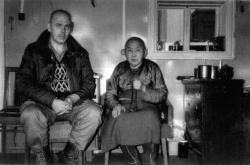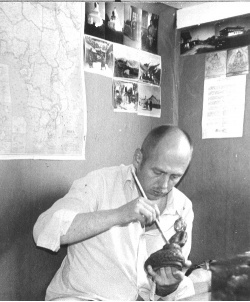About Vello Väärtnõu. 13. September of 1991 by Eve Pärnaste
Vello Väärtnõu was born on 17th of July in Saaremaa. He studied in Kuressaare and was very active in sports, especially in swimming, penthatlon and yachting, being one of the firsts in Estonia. In the year 1972 he came to live in Suure-Jaani and in the summer of the same year he painted his first paintings and became interested in history and philosophy. He finished in distance learning 2 years of high schools grades 10 and 11 in one year, went to live in Tartu and got acquainted with its art life. He studied drawing in Kalju Põllu’s art classes and completed his first graphic papers. Soon Väärtnõu began living in Tallinn. Graphic Alo Hoidre had invited him to design graphic in Art Institute and in the years 1973 – 78 Väärtnõu studied graphic techniques under the guidance of Art Institute’s aster Aleksander Sarri. From studying Buddhist and Taoist philosophy an interest in Eastern art developed, special hobby of his was 12th century Japanese and 16th century Chinese art, he also translated from Russian materials about Chinese art. He also studied painting under the guidance of his friend Jüri Arrak between 1974-80.In 1975 an interest in astrology added and Vello Väärtnõu founded Estonian Astrology Society, lecturing in 1980-82 those who were interested about astrology and Buddhism.
In 1979 Väärtnõu was accepted as member of Artist Union Youth Organization. Next year art scientist Sirje Helme wrote in the magazine “Noorus” (Youth) about him as landscape painter with great future. In September he made his first visit to Buriatya. In 1980 Väärtnõus first paintings made it to Tokyo world exhibition. In 1982 he founded Estonian Buddhist Brotherhood. They translated Buddhist books from English, Russian, German and Finnish language; made Buddha statues and Buddhist thangkas and built 4 stupas in Läänemaa.
At the fall of the same year allegations were fabricated against him and Tarmo Urb of attempt to cross borders. For the lack of evidence he was released in 1983 at may 5th, when commission lead by professor Jüri Saarma testified him being schizophrenic and he was admitted to psychoneurotic hospital for one month. When he was released from there, he found himself expelled from Artist Union with reasoning that he had not paid traffic violation tickets of speeding and his behavior was not suitable with soviet artist behavior norms. The door to exhibitions in Estonia closed.
In 1988 on January 21st 14 Estonian citizens signed a proposal to create Estonian National Independence Party under Vello Väärntõu’s leadership. This was followed by press conference in Moscow. Väärtnõu had organized the printing and spreading of leaflets before the 71st anniversary of Estonian Republic and also printing of anniversary cards. On February 6th KGB conducted search in his place as well as at others and on February 13th he was deported to Sweden.
During his life in exile he has had following exhibitions all over the world, in Europe as well as America and Asia. Already in the end of May 1988 his first exhibition took place in one of Stockholm’s art galleries (pictures were painted in his hotel room, where a quarter of meter free space was in between 2 beds). Many of these works are now in Sweden in private collections of Björn Halgren, Göte Terseus and others. In the years 1993-1998 Väärtnõu lived in Asia, Himalaya and now is mostly living in Stockholm, Sweden.
How to characterize the art of Vello Väärtnõu.
In his case it is not important if he has completed figure composition, landscape painting or abstract picture – the determinatives are color, texture, factures. Recently he has usedmixed techniques and deriving from Japanese valued opinions that all that is old, isgood, gives his pictures scent of old – mainly with the choice of colors. The density anddeep gamma of colors of many of his paintings brings old masters of Europe to mind.
Long friendship with one of the first avant-gardist of Soviet Union Gleb Bogomolov (St. Petersburg) has also left its mark in his works. And since Väärtnõu had studied thangka paintings, his color use is oriented to eastern art principles, which consider the effect of colors to psyche under very strict rules. All in all Väärtnõu’s paintings mostly do depict psychic states of mind. Buddhist view says that reality is illusion of our consciousness, what we receive with the help of our senses is illusion and the state of our consciousness reflects the surrounding world better than our senses. His pictures are like signpost or guide to psychic analysis. Väärtnõu’s principle is not to depict actual objects but feel himself in relations to surrounding world, because this relationship which expresses itself in psychic state of mind, is more objective and real than the object itself.
Vello Väärtnõu says that a picture does not have to say anything, but create a mood. Picture depicts a moment’s state, looking at it, it is possible to restore that and transfuse to the viewers. Psychic state in the picture is like symbol for interpretation. Väärtnõu uses colors masterfully. I do not know any Estonian artists, who come close to knowing the art of glazing as well as he does. Painting is just part of his activities to which he has dedicated himself. Western media has talked a lot about his political background in connection with his exhibitions, but most important about him, his art in itself and Buddhism.

